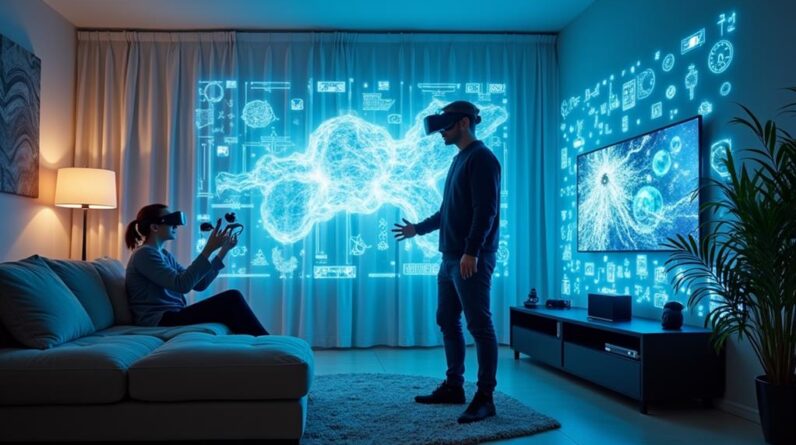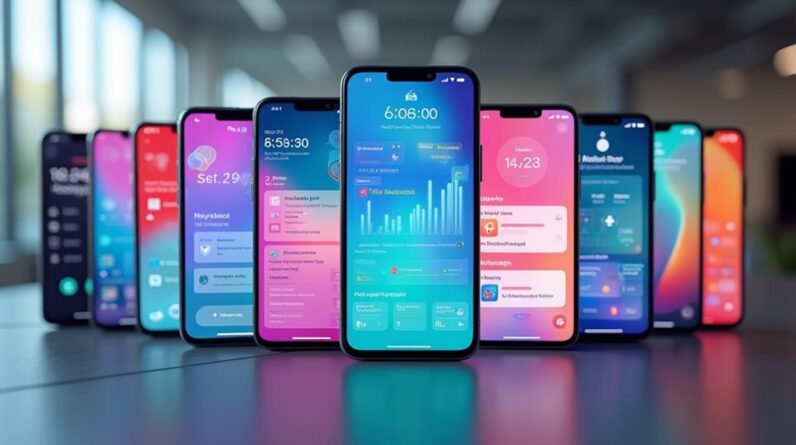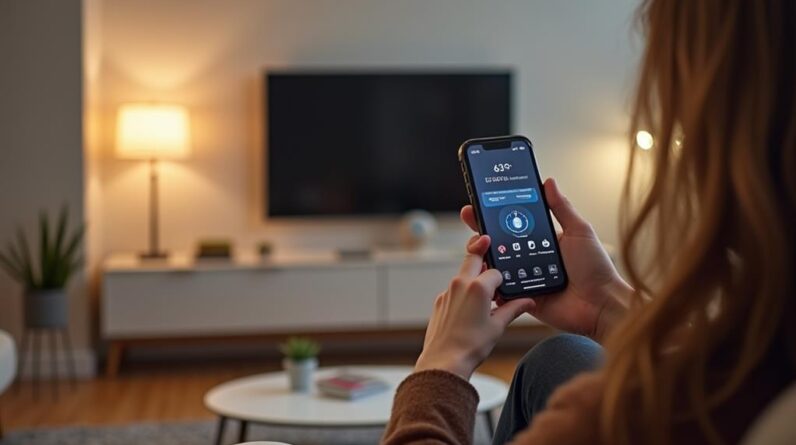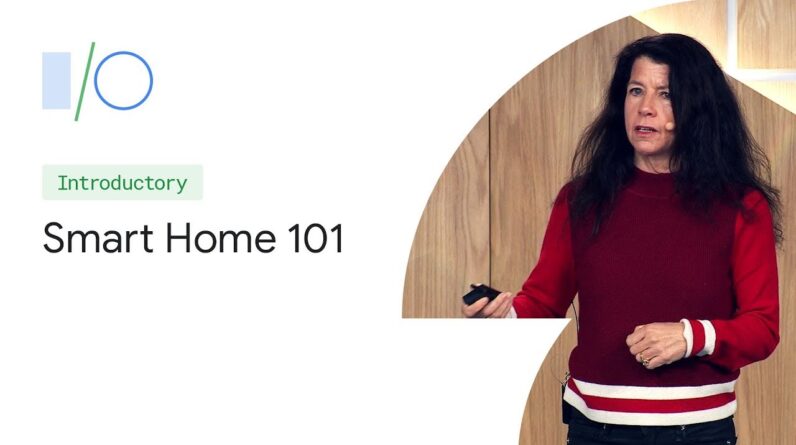
[MUSIC PLAYING] MICHELE TURNER:
I'm Michele Turner. Welcome to Smart Home 101. I'm the director of product
for the Smart Home ecosystem. I am here with my
colleagues, Vera Tzoneva, who runs all of business
development for the Google Smart Home ecosystem and our
technical lead, David Schairer. We are super excited to have
you guys here this morning. So let's talk a little
bit about Smart Home. We've seen the
evolution of technology over the last 30 years,
starting with the PC moving to the internet to smart home. And now we think we're at
the beginning of the stage of ambient computing.
It's interesting if you
look back at the mobile era, mobile went on for a long time
before it really just became very dominant. And it took the advent
of the smart phone to be able to do that. What we're seeing
with ambient computing and smart home is smart home
has been long for a while. I imagine in fact, I know
that there are some of you out there in the audience today
that have X10 systems at home. But it did not actually
start to become something that mainstream users started
to use until the advent of voice in ambient computing.
We really believe that the
next leap in technology in the hardware space is going
to come from the application of AI to hardware and software. So to achieve the
vision of where we're headed with smart
home, two years ago, we launched the
ability for developers, like yourselves, to leverage
the actions on Google Platform to integrate their smart
home devices with the Google Assistant. For smart home
integrations, we focused on making sure
that we could have simple and seamless interfaces
within the AOG console.
This also allows
developers to leverage contextual understanding
that drives the intelligent interactions
with their users. To ensure that this
contextual understanding was available to developers,
we created the Home Graph. The Home Graph is
our technology that understands the
contextual relationships between structures, users,
and devices and rooms. So if you take a look, this is
a super simple representation of the Home Graph. Within the structure, we
have the structured names. So I might have Ramona
as the name my structure. We have the address, we have
the managers of the structure. In my house, it's
myself and my husband. We have all the rooms that are
in the structure, the devices within those rooms, and we also
have a knowledge of presence– is the room occupied or not? We have knowledge of the room. So we have the name of
the room, living room. And we have the
devices in that room. I might have a speaker and a TV. And then we have
an understanding of the devices
themselves– so the name of the device, the type of
the device, is that a camera, is it a light bulb? The traits associated
with that device, so if it's a light bulb,
we would have on/off, we'd also have colors.
In more advanced bulbs,
we have sleep/wake, so lots of different types
of traits and attributes that were evolving with these
different devices these days. And finally, the
state of the device, is that device on or off? All of this information
in the Home Graph enables us to have
apply context to what's going on in your home. And this is what makes
homes truly smart. This also allows us to do
some interesting things. So like in my home
today, if I say, OK, G, turn off all the lights,
all the lights my home go off, which is great at night
when I want to go to bed. But if I'm standing in the
master bedroom and I say, OK, G, turn on the lights,
only lights my master bedroom go on, because it
understands what room I'm in when I'm
making that request. So being able to do more
intelligent interactions like that is what the context
behind Home Graph enables.
So our smart home API
does all the work for you. It's really simple
to get integrated. And I don't know how many first
time smart home developers are in here today, but you can get
going with Our Smart home API very quickly. There's only one API that
you need to implement. We send you the queries
and the commands. You send us your device
information, the state information, and any out
of band notifications, and the Assistant
does all the rest. You don't have to
write any grammar, you don't have to do any
internationalization, we take care of all
of that for you. And we have ample documentation
and reference implementations to help you get started. In fact, if you're interested,
go check out the code labs later on today.
So we've grown a lot
in the last two years, and we now work with over
3,500 brands globally. We would love to have you
as one of our developers if you're not already
started with us today. We work with developers of
all sizes, from Ali Baba– who you've probably
heard of them. They're a very big is
a platform in China, and they provide their
own smart home platform as well that help developers
integrate with the Assistant over in China, FLO by Moen
which is a leak detection system and a valve that
helps consumers save water, the Panasonic Home Energy
Management System that's in Japan.
Energy management
is a big area where smart home can play a prominent
role in our environment. And finally, the TELUS smart
home devices in Australia. So over the last year, we've
really spanned it globally. And we're very excited to see
how this expansion plays out over the next few years. But we're also seeing
a really big shift in how consumers expect to be
able to control their homes. When we think about
the helpful home, it needs to be intelligent,
personal, and predictive. Consumers want a whole home, not
just a collection of devices. And those of you who have smart
devices in your homes today, you know what I mean. They don't interact as
well today as they should, and we need to fix that. They also want simple
pairing and device to device integrations
that just work.
One of the things that's
really challenging is getting these devices online. It's just too hard today still. So later on today at 4:30
right here on the stage, if you're interested,
you can come learn about how we're
doing local integrations, local execution,
and seamless setup through the Google Assistant. It's going to take care of a
lot of these simple pairing and seamless integration issues. They also want a platform
that works for them but always ask permission. One of the things that's really
important about smart home is that we give users control. We can never do
this without making sure users feel
like they're totally in control of their homes. But we have a lot of
contextual understanding where we can enable
things to happen for them. So if we want to be able to
do predictable tasks for them, like if somebody leaves the
house and the garage door is not closed, you want
to probably notify them that their garage door isn't
closed before you just go ahead and close it for
them automatically.
But there are a
lot of other things that are predictable,
like things at bedtime or certain alarms. And within user's
control, we can start to program those to just
happen for the modern magically to make the smart home a whole
lot smarter and more helpful. Finally, we've a lot of sensors
that we are collectively putting into people's homes. And this is going to enable
a lot of new services that together, we're going
to be able to create services around security, around
energy management, and around elder
care and wellness. And this is a
growing trend that I think is really
exciting for consumers. So we started back in 2016.
And we started out with
just a handful of devices– lights, plugs,
thermostats, and switches. And we've grown pretty massively
over the last few years. And this year in 2019,
you can connect everything from your fireplace to your
pergola and pretty much everything in between. If you have a device
that you're developing and it's not on here, please
find one of us over the Sandbox a little later, because
we can help you with that. So let's talk about the
basic smart home with the AOG platform. We have a really simple core
model with our smart home API. We use device types to represent
the taxonomy of the devices. A light is a light,
a vacuum is a vacuum. And even if you created
all kinds of cool features within your device, they're
just a basic device type to us.
Device traits is where we
start to differentiate. The device traits give us
a lot of functionality. And they're the building blocks
for the new device types, as we'll see more in
the demo that Dave is going to give you in a minute. And finally, as I talked
about the Home Graph is where this all comes together
and allows the assistant to help make the smart
home truly smart. We've really focused a
lot on developer tools and ease of use. And in fact, we've added
a lot to the AOG console this year for smart home.
The devices that we're doing
now, like appliances and home security, in many ways are a lot
more complex and the devices we were starting with in 2016. However, we've made
developing with a smart home API a lot easier, and it's
also a lot more process driven. In fact, one of the
things that we've done is we've enabled a self
certification program that we just recently
launched that will help you get through the
certification process more quickly and get your device
in market with the Assistant a lot faster. Our cloud to cloud APIs are
lightweight and easy to use. And the majority
of our developers integrate very quickly. In fact, most of
the integrations are up within six weeks,
but we've actually had some developers be able
to get their integrations up in a day.
So it really just
depends on what you have, your past experience, and the
complexity of your integration. So let's talk about some of the
new things we have coming out. We have a lot more functionality
coming out this year. We have a bunch of new traits,
including Dispense, new app capabilities, account linking,
and some expanded languages. So traits, traits
are the behaviors of devices that are invoked
through the smart home grammars. Lock and unlock is a pretty
simple example of that. We have a lot more
complex traits that are coming out this year. The traits, like
lock and unlock, can apply to multiple devices. So something like unlock and
a lock can be used for doors, but they could also
be used for windows. And they're invoked
through grammars such as, OK, G, lock the front door. What's interesting is that our
trait model is not specifically matched to a device.
They can be applied to a
lot of different devices. Take zones for an example,
which we released this year. We originally developed
the zone trait to work with robot vacuums. There are new
robot vacs that can go understand and map
an open floor plan house and mark off a living
room or a kitchen. And you can just say,
OK, G, clean the kitchen. And even if you're an
open floor plan house, the robot back knows
exactly what area to clean, because it knows
what zone that is. It's pretty cool. Then we started working with
some sprinkler developers like Rocio and Rain
Bird and they said, hey, we have zones too. So the zone trait is now
used for sprinklers and robot vacs, something that's just
pretty obvious when you think about it but not something
that you would necessarily be aware of when you're
first thinking about "traits" relative to devices.
You could check out the Sandbox
for examples of our new traits we have. Most of these new
traits that we have are being shown in
the sandbox today. You also get touch for free. And we are seeing while
voice is awesome for most use cases for the smart home,
touch is being used a lot. Consumers have an option
of using the Google Home app, the Google Assistant,
app or the Google Home Hub.
And with the Google Home Hub,
we have the Home View on there. The Home View
actually you can see looks very much like
the interface that's on the Google Home
app today, making it a really consistent user
experience for yoour consumers. And because your devices are
integrated inside the Home Graph, all of this information
is pulled out of the Home Graph and into the UX on our
displays and our apps so that is just
completely mirrored, and you don't need
to do any extra work to have your devices show up
in any of our touch controls. Next slide. We've also expanded the
functionality in the Assistant app to show the home's summary. So you can see it's
72 degrees at home and the living
room lights are on and the backyard camera is on. We've added a lot
of new functionality into the Assistant app to really
represent the smart home well. So Vera's going to get
a lot more into this, but one area that we're
super excited about this solves a big problem
for smart home users is improved account linking.
For those of you that
are partners today, we know that we struggle
getting consumers to link from your device into
the Assistant from your app into our app. This can be a real challenge. So we've added two things. One is seamless setup
through the local home SDK. And the other is something
calling Google account linking, or App Flip. And App Flip is really easy. I'm going to let Vera tell
you more about it in a second.
But it essentially
just lets you go from the Home or the
Assistant app into your app and back through
the OAuth process, making it significantly easier
and streamlined for consumers. We're also doing a ton of
international expansion. And I think this is a
great area where Google can leverage a lot
of our core strengths around internationalization. We added 18 different
languages in 2018. We're adding another
18 this year, bringing this up to over 36
countries by the end of 2019. And just by integrating
with the smart home API, you get language
support for free. You don't have to do
any additional work. So if you want to expand
into a new country, you're pretty much assured
that the languages, the grammar will work for that country
that you're expanding into.
And finally, I want to
touch on Report State. Last year at I/O, we
announced Reports State, and you guys have been awesome
about providing State reporting into the smart home API. But one of the things
that I wanted to touch on is we've gotten a lot of
feedback from our developers, from you guys, about how
we could do this better. So we've added a few things. If you have multiple devices
that you want to OAuth through, you can now let your users
choose which devices they want to provide State to Google
through the OAuth process, which is great. It gives users more
control over their data. Another thing to remember is
that State data is ephemeral. We don't hang on to this data. And finally, this data is
only used in Home Graph. We get a lot of questions
about, well where do State data? The data is only held
in the Home Graph.
It doesn't go into any of
Google's other systems. So you can rest
assured that that data is really protected
and used only to help the contextual
understanding, because it is an odd experience
if we don't have State data and somebody says, OK, G, lock
the door and then they go up and they look on their app or
they look on one of the Home Hubs and they go away, oh
wait, I locked the door, why is it not showing
that the door is locked, it's a really confusing
experience for consumers. So State's super important,
but so is privacy. So we are doing our best to
apply both of those things. All right. That's it for me. I am going to hand it
over to David right now. And he is going to show
you, among other things, how to protect your cookies Thank you so much, Michele. So when we talk in terms of
features of the smart home ecosystem, we break this down
into four categories in fact– lights and switches– pretty obvious.
On/off color
brightness– integration with [INAUDIBLE] and
[INAUDIBLE] and so forth. Entertainment devices,
much more complex. Media initiation,
media control– lots of complexity around
targeting and understanding five smart devices in one
physical stack of media devices. Home security, security systems,
cameras, alarms, sensors, doorbells. And then energy
comfort and control, that's everything else. It's your appliances. It's your vacuums. It's your bathroom utilities. Sort of all the things
that make your home be not that box, but
actually a lifestyle. The nice thing is that all of
these four things, these four verticals, are really the
same API, the same ecosystem. And you can build
one integration and then add in all the
devices that you support. And increasingly, as
we add new features, as you add new features,
grow your ecosystem and our ecosystem over time. We talked a lot about commercial
products in the marketplace. And you've seen lots
of commercial products on store shelves using
the Google Assistant and using Smart Home to
integrate their devices.
But there's a lot more that can
be done for individual users, for makers, for
developers, for education, all using the same ecosystem. In fact, we have several orders
of magnitude, more developer accounts and developer
setups in the system than we have
commercial partners. And if you're a maker, if
you're using this stuff at home, if you're doing hacker
projects like this, this whole ecosystem
is available to you. I was visiting a friend's
house a few weeks ago, he has 700 Smart Home devices
all set up in his house. He's all done
individual integrations using his own on prem
implementation of our APIs to do a really, really
personalized implementation. He has more time
than I do, clearly. But he's done a significant
job to make all voice control, all assistant touch for an
entirely custom home build.
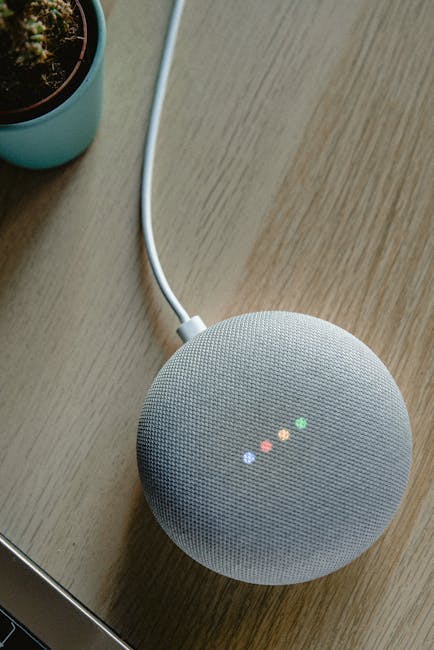
If you're are a developer, if
you have a prototype product, you can use our developer
APIs to prototype you the entire experience, have
everything available for demo, do your drive up and
down Sandhill Road, hardware in hand with
full voice integration. We don't need to prove that. It's just all available to you. And likewise, we have
a tremendous number of STEM projects in the system. College, high school, even
some junior high folks that are learning
how to code, very easy to take some
of the open source platforms they already
have, like Home Assistant, integrate it with a Raspberry
Pi hardware project. And for anyone who's
learning how to program, have full voice control, full
touch control over whatever device they happen to make. As Michelle said, we have
two innovation paths. I'm going to demo
the cloud today. The cloud is what we've had
since the start of time, which for us is late 2016. Very easy to build. Very easy to deploy
if you already have cloud infrastructure.
And then, later today, we'll be
launching our local Home SDK. It uses exactly the same
design language, same type, same traits, same API
representation of things, but you can actually run your
controller on our hardware. You don't need to run all
your stuff in the cloud. It's much more scalable
for you because you don't need to deploy your
cloud at the scale of events. [INAUDIBLE] devices
for onboarding. And performance, of course, is
inside Google, and improved. So please, come by, if you
can, 5:30 on this stage, with my counterparts
[INAUDIBLE] are going to be presenting that. If you're watching
this on YouTube, you should be able to see
that talk somewhere over there, or possibly down
here, because I'm sure it'll be related to this one. Again, the Local Home SDK
works the same as the cloud. You can integrate with the
cloud to get your device sync and query, and then
use execution and state management directly on the local
network with the Google Home Devices. You don't need a Google device. The Cloud still works. But you have the local
path available to you for that high performance,
highly scalable infrastructure.
Now, I'm going to turn it
over and do some demos here. We have– log-in– we have here a little
hacker smart device project. This is the same
cookie jar that we have over in the sandbox
in the assistant tent two buildings over. It is– it's logged
me out, of course. This is basically a permanent
electromagnet on the lid. Right here I have a
Raspberry Pi controller that connects to the cloud. I have a cloud instance
running on our little Debian 9 instance that has the cloud
controller this connects to and implements our API. So I have already built
over here in the Actions on Google Console a Smart
Home project, that's this cookie jar project here. And I have set it up with OAuth. The basic stuff. All the instructions on this
are in the documentation that was linked earlier. It'll be in the final slide.
So I can see I have set up OAuth
already with some client keys that you shouldn't copy– and you don't need that. And then down here, I have
an action I have set up. This here is my cloud instance. So that's the OAuth. Where'd I go here? Build, Actions– Actions– here we go. There is my execution path. Both Of these point to the instance
I'm about to show you.
And went on with
that, I now over here have a Node.js instance running. The Node.js instance, which
I'm going to now restart, is running the command
and control software. It is running Nginx
in front of Node.js. That connection is the
Raspberry Pi here connecting to the cloud controller. So now, if we can cut
over to the phone. Can we cut to the phone? Perfect. I'm going to go in. I'm going to set up a device. This is using the
standard build. Whoops. I've already connected that. Let me disconnect that and make
sure that this has good states. I'm going to to restart that. I'm going to connect again here. And I have a login screen. I have a login screen. There we go. I log in. I've got the
password saved there. Don't do that in
production, obviously. Now I have a cookie
jar device hooked up. And I should see it
right down there.
Cookie jar showing us a
lock, because that's how it was implemented in that code. Now, if I go back
to the Assistant– open the cookie jar. Ca va. Cookie jar has opened. [APPLAUSE] Now, unfortunately, we
were not allowed by legal to actually do
real food on stage, just like Michelle said earlier,
but my wife and her friend– my wife, Nina, and
her friend [INAUDIBLE] made all these
cookies last night, and I said I'd give them a shout
out, so shout out for cookies. I will now consume and talk
with my mouth full on stage. Snickerdoodles are awesome. Contact me later for the recipe. The problem is that cookie
jar is openable to anybody. They'll have to come
over and take a cookie, and we don't want
that to happen. VERA TZONEVA: What? DAVID SCHAIRER: Sorry. So– VERA TZONEVA: Wait a second. DAVID SCHAIRER:
Sorry– not sorry. So what we're going
to do here is– lost my windows.
Here is the execution code
that runs that first version. So without a pin, it simply
responds and executes the open command. That's the open command
that's returned– the response is returned
and it passes through and it sends a command down the
pipe to this, the Raspberry Pi, which, actually, it's a
pin, which pops the magnet. However– I've already
got the code here, so I'm going to
change this to true. Now, we're going to
go down to this code. And when this executes,
when the request has no pin, we're going to send a
pin challenge right here. So instead of opening
the jar, we're going to send an error
that says we need a pin.
And if we have a
pin, but the pin does not match the constant
that's up at the top– again, in real code you'd
do that from a database– then it's going to
generate a repeat pin. So now I've written that. It's now pin needed. I go back to my other window. I'm going to restart my
little node instance.
Up it comes. There is the connection
from the device. And now– open the cookie jar– 1759. Whoops. 1805. [APPLAUSE] So now we've implemented
a true FA feature– you saw was about
20 lines of code. And the nice thing about the
second– for the true factor authentication is you as
the partner can decide when and how to challenge. So if, for example, you wanted
to make a cookie jar that was locked before dinner
but available after dinner because you don't want your kids
eating cookies before dinner, you could absolutely do that. If you had a cookie jar with
an NFC, so you had a dongle, and you waived it, and you said,
open, you could do that too.
With a second factor,
we don't know about. So you have that
in your control. And the true FA feature is
available on pretty much all of our traits. So if you want to have
a cookie jar– obviously it's designed for
security systems, door locks, and so forth,
where it's really mandatory to have that second
factor of security– but it's also available on
whatever interesting devices you might happen to make. Can we go back to the slides? Perfect. So everything I just did was
available with all developers, all makers, educational
projects, what have you. No approval, no launch needed. You put it, you do your project,
you can share that project. Anybody that you share
it with can run it. It's very much like with
any App Store or Play Store, having a feature that
you can share internally. If you want to launch
it to the masses, we have a process Vera
will talk about more. You go through the same portal. You have self-testing tools. And it's usually pretty
fast, the partners, to get these into
full launching, which is what I'm going to
hand over for Vera to do.
VERA TZONEVA: Awesome. DAVID SCHAIRER: With my cookie. VERA TZONEVA: All
right, all right. I seriously can't have one? [APPLAUSE] Cool. You know when you get
home exhausted from work, all you really want to
do is set the thermostat to heat up your freezing house,
start doing all of the laundry, start preparing a big
meal for your family, then do all the dishes, then
prepare for the next morning? No? We just talked about
how we're going to solve for a lot of this
with the Connected Home. And once we solve these
problems for users, they're going to start
expecting it, which is really good news for all of us here. From the thermostat developer,
to the oven developer, to the dishwasher developer,
to the device we didn't even know we need a
developer, we're all going to grow the Smart
Home ecosystem together.
Look at the data. The number of connected
homes in the next 5 years is set to grow 10x. That's amazing. And of those homes, the number
of connected devices already today in those homes is
10, and over 50% of users are using connected
devices every single day. That's amazing. But what's different? What's changed? Well, incredibly,
over 44% of users have used an assistant to
control a connected device. How do these trends benefit you? And how are we here to help? Well, number one, we can
help deepen user engagement. Number two, we can help
increase your device sales. And number three, we
can drive brand value. So let's walk through each of
them, starting with engagement. Let's remember
that the assistant is live on 1 billion
devices, so we want to help enable your reach. Two, we want to solve for
the device discovery problem. It's been a problem that's
been plaguing our industry for a very long time.
And then the third is we
really want to help with setup. It's still way too
full of friction. Let's start with reach. Remember that the assistant
is live one 1 billion devices. That's on mobile phones, it's
on speakers, it's on displays, it's on cars, it's
on TVs and much more. So remember you're a user,
he or she is driving home and wants to preheat the
oven or set the thermostat. Now, you as a developer have
access to that user on the go, and you have to do nothing else. Let's also remember
that the assistant is live internationally. And the connected home
market, your customers are also growing
significantly internationally. So when you build for
the smart home API once, you get access to
all those users across different locales,
countries, languages entirely for free. We need– we're doing
a lot to actually solve for discoverability as well. Remember, I mentioned
that on average a user has 10 connected devices
in his or her home.
What we've already launched
is an ability for a user to discover the devices directly
in the Home app in the feed through something
called Suggestion Chips. When an user taps
on that, they can start connecting the device. The next thing we're doing
with discoverability, and I'm especially
excited about this one, remember the reach
that the assistant has on mobile devices. We're going to be
sending notifications to users on Android and iOS. We'll have a third
party app downloaded encouraging the user to
connect and set up the device.
But that's not only
going to be it. We're also, through
those flows, going to start educating the user
on the benefit of connecting the device. So think about everything
that you do every single day to make your device connected. You think about all
the new features you're going to launch,
all the functionality, all of the smarts,
things like this are going to help bring your
features to the forefront. We need your help. We're doing a lot of work across
our ecosystem of developers to help with this
discoverability. So our partners are doing
things like launching badging on boxes, or putting
inserts in packaging. They're also doing a lot
within the UIs themselves, so the UIs within a TV, or
within a third party app. And they're doing
a ton across things like email, press,
and other campaigns.
We actually did a
program with Vizio where the partner launched
a education flow directly on the TV on the
benefits of connecting to the assistant, that
discoverability of features, and they saw a 10x
increase in the number of connected devices. All right. So we've talked about reach. We've talked about
discoverability with an engagement. Now, let's talk about setup. How many horror
stories have you heard of your customers struggling
to set up a connected device? I am embarrassed
to say I sometimes have a problem setting
up a connected device. I know my team does as well. I'm legitimately worried
that our industry is going to change the sentry
old joke of how long does it take to screw in a light
bulb into how long does it take to set up a connected
device, and I don't want to be here when that happens. We want to prevent
that from happening. So we're doing a few things.
Yesterday we announced that
we're opening up the local home SDK. This is the first step. It enables local execution. It allows things like the
Home Hub or the speaker to be able to identify
devices nearby. The second thing we're doing
is Google account linking. So if a user starts within
the assistant experience and then goes to your app to
accept the terms of service, they can then flip back to
the assistant experience without having to re-enter
username, password, credentials, which we know is
a significant friction point.
All right. So we've talked a
lot about engagement. We've talked about reach. We've talked about the ability
to solve discoverability. We've talked about set up. Now, let's talk about sales. We know that the
reasons users are buying connected devices are for
convenience and cost for value. An incredibly 89% of customers
are influenced by compatibility of their assistant
when considering which connected device to buy. So what are we doing there? Unsurprisingly, a lot of people
are starting their purchase process directly on search. So we've launched a Works With
Google Assistant attribute on shopping on
search to encourage users to be able to
find which devices work with their assistant. To be eligible, make sure
you register your devices in the Merchant
Center, and then add Works With Google Assistant in
the title and the description.
It's not just on search. We're doing a lot
across other channels. So we work very closely with
our retailers across things like promotions,
fixtures, displays. We're doing a ton
to train installers and our retail partners. We're doing a lot with above
the line marketing, brand marketing, et cetera. But the point here
is, you don't have to be a big company to benefit. Make sure you launch
a quality integration with a great use case, and we'll
do our best to showcase you. All right. Now, let's talk
about brand value. Remember that for users
Home is a sanctuary. It's where they go to
find comfort, care, and to be in control. This is the best
place for your brand.
Once the vision of the helpful
Home becomes a reality, the brands, your brand,
will be at the center of it. Users will use
your devices daily. You'll be the new
household brand. I mean, look at some
of these examples, some of these brands
we didn't even think about or use
just a few years ago, and now we think about
and use them daily. Now, think about this new world. You get home, your house is
warm and toasty when you arrive, the laundry is
already done, the oven is preheat heated
for that pasta dish that you've been dying
to make your family, and the dishwasher is
set to run at night to save you energy and money. And yet, you think about
none of those things, you simply take off your
shoes and hug your family. So when we achieve this as
an ecosystem of developers, users are going to be
using your device daily.
It's why they went
and bought it. And that's why they
know your brand. The benefits to you across
deepening user engagement across increasing your sales
and across driving brand value will all be there. To recap, make sure you
launch the Smart Home API. That's the cloud to
cloud integration. Also, launch the Local Home SDK,
which we announced yesterday. That's what enables
local execution. Also, implement Google
Account Linking. It's what really helps
with what is today a pretty friction full set up process. Register your devices
in the Merchant Center and add Works With Google
Assistant in the title and description.
And then check out
the Marketing Hub. Once you launch, we
want to make sure that we're educating
our mutual users on the benefits of
your connected device and connecting to the Assistant. We have a few upcoming sessions
to deep dive into these topics. Local Technologies for
a Better Smart Home is later this afternoon. It'll also be recorded
and streamed live. And then Tools for Building
Better Smart Home Actions is tomorrow. Also will be recorded
and streamed live.
Thank you so much. [MUSIC PLAYING] .
As an Amazon Associate I earn from qualifying purchases.



